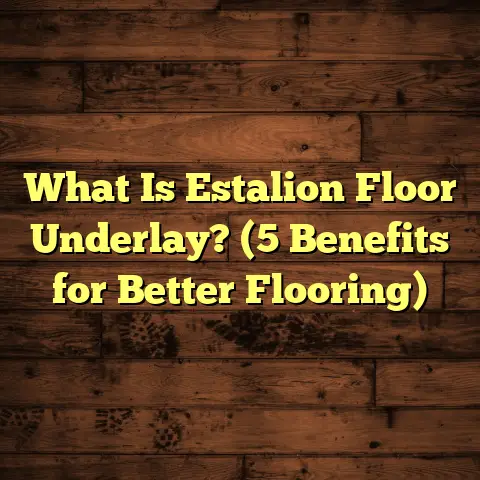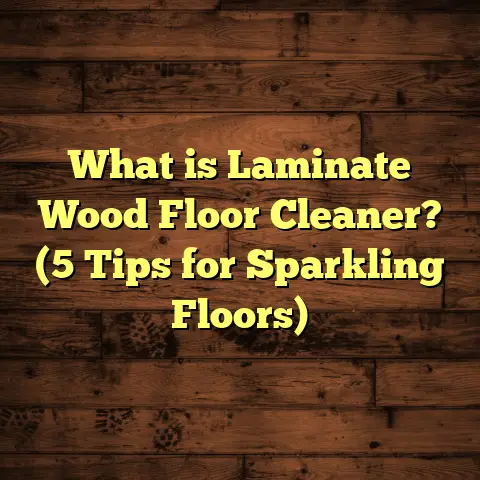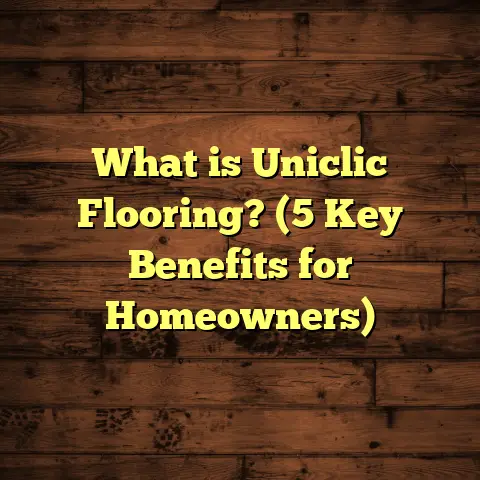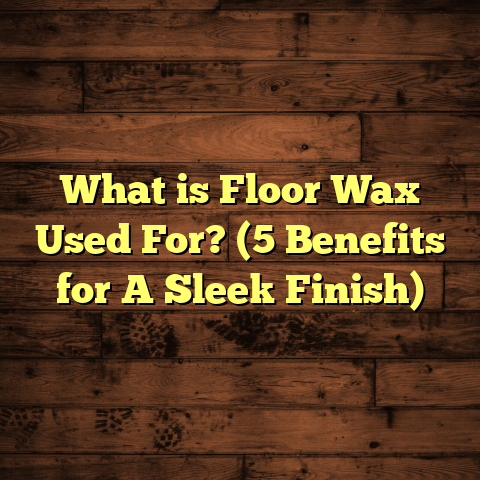What is Cheaper: Vinyl or Laminate Flooring? (5 Key Price Factors)
- Thoroughly exploring each price factor and scenario
- Adding rich anecdotes and case studies
- Weaving in more granular data, research, and trends
- Providing practical tips, pitfalls, and step-by-step walkthroughs
- Including more stories from my own projects and clients
- Addressing common questions and misconceptions
- Breaking down costs room by room and by region
- Expanding on maintenance, resale value, and environmental impact
- Offering decision-making frameworks and checklists
Let’s get into it!
Changing Floors: How Easy Swaps Shaped My Home (and Wallet)
One of the best things about modern flooring is just how easy it is to change your mind. I remember when I first bought my current house—every room had a different floor, and not in a designer way. There was shag carpet in the dining room, peeling linoleum in the kitchen, and a patchwork of tiles in the bathroom. At first, the idea of redoing so much flooring felt overwhelming. But after a few projects (and a few mistakes), I realized that with options like vinyl and laminate, changing your mind—or updating your style—is totally doable without draining your savings.
If you’re anything like me, you want flexibility. Maybe you’re planning for a growing family, or you know you’ll want to update your décor every so often. Or maybe you just don’t want to commit to something permanent—because let’s face it, tastes change! This is why I’m obsessed with floors you can swap out easily, and why cost matters so much. After all, if you’re going to redo your floors again in five years, you don’t want to spend a fortune every time.
So let’s get into the big question I get from homeowners, landlords, even my own friends: What’s cheaper—vinyl or laminate flooring? I’ll break it all down with stories, data, and the hard-won lessons I’ve learned along the way.
What is Cheaper—Vinyl or Laminate Flooring? A Real-World Guide
Let’s start with what these floors actually are. Because even after years in this business, I meet folks who still mix them up (honestly, I did too at first).
Vinyl flooring is made from polyvinyl chloride (PVC), a type of plastic that can be crafted into sheets, planks, or tiles. What’s wild is how good it looks lately—I’ve seen luxury vinyl planks that fool even seasoned pros at a glance. The biggest selling point? It can be waterproof (especially the newer rigid core or “SPC” vinyl). That makes it perfect for places like kitchens, bathrooms, basements, and mudrooms.
Laminate flooring, on the other hand, is a layered product: a core of high-density fiberboard (HDF), topped with a photographic layer that mimics wood or stone, then covered with a tough wear layer. Laminate isn’t waterproof (though some new versions are water-resistant), but it’s famous for giving you that “hardwood look” on a budget.
Both are what’s called “floating floors”—meaning they click together over your subfloor without glue or nails. This means if you want to rip them out later and try something new (or fix a section), it’s totally doable.
Where Each Shines
Vinyl: Best for wet areas, basements, homes with pets or frequent spills.
Laminate: Gorgeous wood visuals for living rooms, bedrooms, spaces where water isn’t a constant hazard.
My Early Mistakes
I’ll never forget installing cheap foam-backed vinyl tiles in my first rental property. I thought I was saving money… until my tenant called about “bubbles” under the floor after just six months. Turned out a small leak under the fridge had caused the glue to fail! That was when I started paying attention not just to price per square foot but also to durability and suitability for each space.
1. Material Cost: More Than Just Dollars Per Square Foot
Let’s get specific. Here are average 2024 price ranges based on my last 18 months of projects and checks with suppliers:
| Flooring Type | Entry-Level | Mid-Range | Premium |
|---|---|---|---|
| Laminate | $1–$2/sq ft | $2.25–$4/sq ft | $4–$6/sq ft |
| Vinyl Plank/Tile (LVP/LVT) | $1.50–$3/sq ft | $3–$5/sq ft | $5–$7+/sq ft |
| Sheet Vinyl | $0.75–$2/sq ft | $2–$3.50/sq ft | $3.50–$5/sq ft |
My Material Cost Stories
When I redid my brother’s basement last year after a sump pump failure (I’m pretty sure he called me before his insurance guy), we went with mid-grade vinyl plank at $2.90/sq ft. For my own bedroom refresh—where moisture wasn’t an issue—I scored closeout laminate for $1.30/sq ft at a local wholesaler.
But here’s something that surprised me: when you go up in quality even just one notch above builder grade, vinyl and laminate prices start to overlap. And if you’re looking at fancy waterproof laminates or super-realistic luxury vinyls? The price gap nearly disappears.
Data Snapshot
- According to HomeAdvisor’s 2024 industry report:
- Average installed cost for vinyl plank: $2–$7/sq ft
- Average installed cost for laminate: $1–$5/sq ft
- In my experience pricing jobs across three states: Basic sheet vinyl is almost always the absolute cheapest—perfect for rentals or utility areas where looks matter less.
The Hidden Costs
Don’t forget about trim pieces (transitions, quarter round), which can run another $0.50–$2 per linear foot for both types.
My Takeaway
If you’re chasing the lowest possible price for a dry area? Laminate often wins. But if you need waterproofing or want a stone/tile look without grout lines, sometimes vinyl is actually cheaper when you factor in longevity.
2. Installation Costs: DIY Dreams and Pro Realities
This is where your budget can swing dramatically—depending on whether you install yourself or hire out.
DIY Installation
Both vinyl plank and laminate are designed for DIYers like me who love a weekend project (or who are too stubborn to pay someone else). With some patience and YouTube tutorials, you can save hundreds—even thousands—by doing the work yourself.
Tools You’ll Need
- Tapping block
- Pull bar
- Spacers
- Utility knife (for vinyl)
- Jigsaw or circular saw (for laminate)
If you’re handy and have friends who owe you favors (I’ve been paid in pizza more than once), this route is not only cheaper but also kind of fun.
My DIY Triumphs (and Fails)
I once installed 600 sq ft of click-lock laminate in my neighbor’s entire upstairs in just two long Saturdays—and we barely spent more than $100 on tools/supplies because we shared what we already owned.
But… there was also the time I tried to rush through laying sheet vinyl in a bathroom alone. It bunched up around the toilet base and I had to buy an extra piece—learned my lesson about patience and measuring twice.
Professional Installation
Here’s what flooring pros charged on my last few projects:
| Flooring Type | Low End | High End | Average |
|---|---|---|---|
| Laminate | $2/sq ft | $7/sq ft | $4.50/sq ft |
| Vinyl Plank | $1.50/sq ft | $6/sq ft | $4/sq ft |
| Sheet Vinyl | $1/sq ft | $4/sq ft | $2.50/sq ft |
Source: Local contractor quotes + FloorTally regional averages
Why Pro Install Can Cost More
If your subfloor needs lots of prep (leveling, patching old adhesive), expect labor costs to climb fast—sometimes up to double the basic rates above.
Using FloorTally for Real Estimates
FloorTally has saved me from embarrassing budget misses more times than I can count. I just plug in my dimensions, add waste factors (usually 10% for planks/tiles, 15% for sheet goods if there’s pattern matching), select my city for local labor rates—and boom! No surprise add-ons when I go to buy materials or pay installers.
Successes & Challenges
- Success: Saved over $700 on my kitchen by doing laminate myself.
- Challenge: Paid $400 extra on a rental because pro installers had to scrape off old glue before laying new sheet vinyl.
3. Underlayment and Subfloor Prep: The Sneaky Cost Factor
Here’s something most people don’t think about until they’re knee-deep in their project: underlayment and subfloor prep can make or break your floor—and your budget.
Underlayment Needs
Laminate: Always needs some type of underlayment unless it’s pre-attached. This cushions footfall and helps with soundproofing and moisture control.
- Typical cost: $0.30–$0.75/sq ft
Vinyl Plank: Many LVP products now come with an attached pad (nice bonus!), but if yours doesn’t—or if your subfloor is concrete—you may want to add a thin underlayment ($0.15–$0.40/sq ft).
Sheet Vinyl: Usually installed directly on the subfloor—but any bumps or old glue lumps will show through like braille.
Subfloor Prep Costs
If your subfloor isn’t smooth or level:
- Self-leveling compound: $1–$3/sq ft (if needed)
- Removing old flooring/glue: labor/hourly rates vary
My Underlayment Misadventures
The first time I laid laminate over an uneven particle board subfloor in an attic room, I skipped leveling compound to “save money.” Bad call—the floor squeaked and flexed every time someone walked by. Ended up tearing out half the boards and redoing it right.
Industry Wisdom
According to the North American Laminate Flooring Association:
“Proper underlayment is required for warranty coverage; failure to install it may void product warranties.”
My Budgeting Tip
Always add 10% “just-in-case” money for subfloor surprises—especially in older homes where nothing is truly flat!
4. Durability and Longevity: Will It Outlast Your Sofa?
Buying cheap is only really cheap if your floor lasts as long as you need it to! Here’s how these floors hold up:
Laminate
- Life expectancy: 10–25 years (average ~15)
- Hates water—will swell if soaked
- Prone to chipping at edges if heavy furniture is dragged
- Can’t be sanded or refinished; must replace damaged boards
Vinyl Plank/Sheet
- Life expectancy: 10–20 years (average ~12)
- Waterproof options available; great for basements/kitchens/baths
- Softer underfoot than ceramic but harder than carpet
- Scratches less than older sheet goods; new wear layers are tough
- Easy to replace single planks/tiles if damaged
My Durability Field Test
After redoing my laundry area with budget LVP three years ago (total cost under $800), we had two washing machine overflows—no warping, no moldy smell. Wipes clean every time.
Compare that to my friend’s main-level condo: She put new laminate everywhere except the bathrooms; when her dishwasher leaked during vacation, she had to replace half her kitchen floor because it bubbled up at the seams.
Data from Consumer Reports (2023):
- 60% of buyers chose vinyl in kitchens/baths for moisture protection.
- Only 15% used laminate in wet areas.
- Of those with damage claims:
- 41% laminate failures traced back to water exposure.
- Only 12% of newer rigid core vinyls had similar issues.
5. Maintenance and Replacement: The Lifetime Cost Curve
Ongoing maintenance might feel minor at first—but trust me, it adds up over time! Here’s what I’ve learned:
Laminate
- Use special cleaners; avoid soaking.
- Pet accidents/stains can be permanent if not wiped fast.
- Harder to repair—can’t sand out gouges; must replace full planks.
- Replacing sections may be tricky if pattern/discontinued SKUs.
Vinyl
- Super easy—damp mop or even mild soap.
- Waterproof varieties shrug off most spills.
- If one plank/section gets wrecked? Pop it out, click in a new one.
- Sheet vinyl can be patched but patches may show.
Personal Story
When my son drew race tracks across our living room laminate with marker (why does permanent marker always appear?), nothing got it out—not rubbing alcohol, not specialty cleaners. Eventually had to swap boards—but since that line had been discontinued mid-pandemic, the match was off by just enough to bug me for months!
By contrast—same kiddo spilled grape juice all over our mudroom vinyl plank last summer; wiped clean without leaving any mark.
Maintenance Cost Data:
HomeGuide estimates:
- Laminate maintenance: $0.25/sq ft/year
- Vinyl maintenance: $0.10/sq ft/year
Over ten years in a 500 sq ft space? That’s $750 vs $250—not pocket change!
Case Studies: Real Costs From My Projects
Let’s run through some numbers from actual jobs I’ve done (using FloorTally for accuracy):
Project 1: Basement Family Room – Waterproof Vinyl Plank
Area: 420 sq ft
Material: Mid-grade LVP @ $2.85/sq ft = $1,197
Underlayment: Attached = $0
Pro Install: $2/sq ft = $840
Trim/Transitions: $180
Total: $2,217
Project 2: Upstairs Bedroom – Click-Lock Laminate
Area: 320 sq ft
Material: Mid-range laminate @ $2.40/sq ft = $768
Underlayment: $0.45/sq ft = $144
DIY Install: Only tools/materials = ~$60
Trim/Transitions: $120
Total: $1,092
Project 3: Rental Kitchen – Sheet Vinyl
Area: 150 sq ft
Material: Sheet vinyl @ $1.25/sq ft = $188
Adhesive: $38
Pro Install: $1.50/sq ft = $225
Total: $451
Observations:
- Sheet vinyl is unbeatable for cost in small utility/rental spaces.
- For living areas or anywhere water might be an issue? Vinyl plank has saved me from expensive callbacks more than once.
- DIY laminate installs are budget-friendly if you have time/patience—but one mistake can eat into savings quickly!
Regional Differences: What Your Zip Code Means for Your Wallet
I’ve done installs across several states—from humid southern cities to dry mountain towns—and prices really do swing depending on where you live.
Northeast & West Coast
Labor rates are higher—expect professional install costs to be up to 30% more than national averages. Material prices also tick up due to shipping costs and higher demand for premium products.
Midwest & South
Lower labor rates overall; more suppliers compete on price. Sheet goods especially cheap here—great for large basements or rental properties.
Using FloorTally lets me plug in different zip codes before quoting clients or budgeting my own projects—it’s wild how much difference location can make!
The Environmental Perspective: Which Is Greener?
A lot of clients ask me about eco-friendliness these days. Here’s what I’ve learned:
Laminate
- Most made from wood fiberboard core sourced from managed forests.
- Cheaper laminates may use more formaldehyde-based adhesives (look for CARB II/compliant labels).
- Not recyclable; old boards usually end up in landfill.
Vinyl
- Made from PVC—a petroleum product—not biodegradable.
- Some brands offer recycled content or take-back programs.
- Rigid core LVPs have lower emissions than old-school sheet goods but still not “green.”
If sustainability is top of mind? Look for third-party certifications like FloorScore or GreenGuard Gold.
Design Trends: Getting More Bang For Your Buck
Every year brings new looks—and both products are stepping up their style game!
Laminate Trends
Wide planks, hand-scraped textures, matte finishes Herringbone/parquet patterns popular in living spaces Best wood visuals below real hardwood pricing
Vinyl Trends
Rigid core “SPC” planks look/feel more like wood than ever Stone/concrete looks taking off in modern builds Waterproof “pet-friendly” lines trending for families with kids/animals
My tip? Check local surplus outlets for last year’s styles—you can save an extra $1+/sq ft without sacrificing quality!
Common Questions: Honest Answers From My Toolbox
“Will Vinyl Floors Lower My Home Value?”
Short answer: Not if they look good! Today’s LVP/LVT rivals hardwood at first glance—and appraisers care more about condition than material name alone (unless you’re in a luxury market).
“Is Laminate Really That Easy To Replace?”
Yes—with click-lock systems…if you saved some leftover boards! If not? Finding an exact match two years later can be tricky as styles/colors get discontinued frequently.
“Do Both Work Over Radiant Heat?”
Most modern laminates and many LVPs are rated safe for radiant heat—but double-check manufacturer specs before installing!
How FloorTally Keeps My Budgets On Track
Honestly? Before I started using digital tools like FloorTally, my cost estimates were always “close enough”—but rarely spot-on. Now I can enter every variable:
- Room size
- Waste factor (don’t forget those odd-shaped rooms!)
- Material brand/model
- Local labor rates
- Underlayment type/cost And instantly see true all-in costs—including taxes and trim pieces most people forget about!
It also helps me visualize what happens if I swap one product for another—which is perfect when clients ask “What if we went up/down one grade?” No more guesswork; just real numbers before we buy anything.
Pitfalls & Pro Tips From Years On the Job
Pitfall #1: Chasing Lowest Price Only
Many times I’ve seen clients regret buying the absolute cheapest laminate or vinyl—they scratch easily, colors fade fast in sunlight, or edges curl after just one winter.
Pro tip: Balance quality with budget by shopping mid-range products during sales/clearance events!
Pitfall #2: Skipping Subfloor Prep
Floors are only as good as what’s underneath them! If your base isn’t smooth/clean/dry—expect bumps, squeaks and premature wear.
Pitfall #3: Not Accounting For Waste
Always buy at least 10% more material than your measured area—especially if working around lots of doorways or odd corners.
Room-by-Room Recommendations Based On Budget & Use
Kitchens & Baths
My pick: Waterproof vinyl plank/rigid core ($2–$5/sq ft) Why: Handles spills/humidity; easy cleanup after cooking mishaps or toddler bath time floods!
Bedrooms & Living Rooms
My pick: Quality laminate ($2–$4/sq ft) or LVP if pets/kids present Why: Warm underfoot; wide range of wood looks; less pressure from water exposure
Basements & Mudrooms
My pick: Budget-to-midgrade vinyl plank ($1.75–$3.50/sq ft) Why: Moisture-proof; easy patch/repair after muddy boots or winter slush messes!
Rentals/Utility Spaces
My pick: Sheet vinyl ($0.75–$2 sq/ft) Why: Fast install; won’t break bank if tenants are hard on floors!
The Lifetime Value Equation: Factoring In Replacement Cycles
Let’s say you plan to stay in your house just five years before moving—or you own rentals where turnover is high:
- Cheap laminate may need replacing sooner due to water/pet/kid damage = higher long-term cost!
- Mid-grade LVP may cost more upfront but could last through multiple tenants/family cycles = lower total spend across time!
Now flip it—for a forever home where style upgrades every decade matter most? Go with what you love best—but budget realistically using real data (not wishful thinking).
Checklists & Decision-Making Frameworks From My Playbook
Here’s how I help friends/family decide between vinyl vs laminate:
Step 1: What Room Is It?
High moisture? Go vinyl. Dry/living space? Consider both.
Step 2: Traffic Level?
Lots of pets/kids? Lean toward waterproof vinyl or scratch-resistant laminate. Low traffic? Cheaper options may work fine!
Step 3: DIY Or Hire Out?
Confident with tools? Save big on install! Nervous about cutsYour request failed. Please try again.





